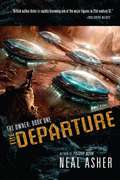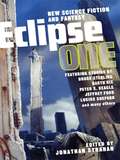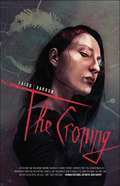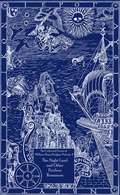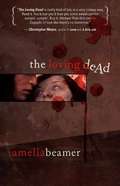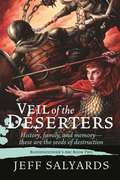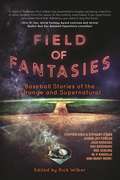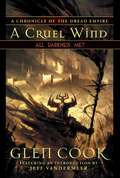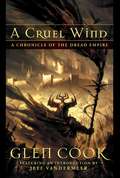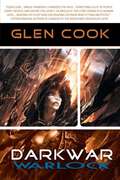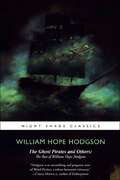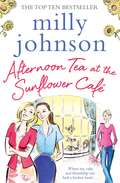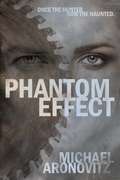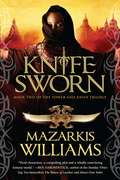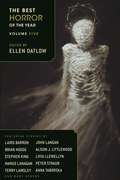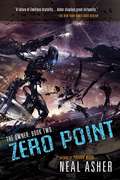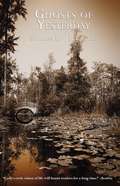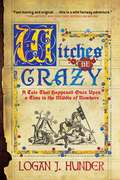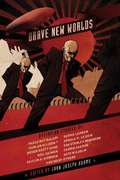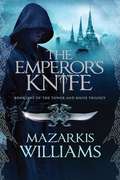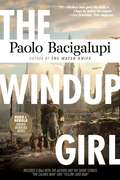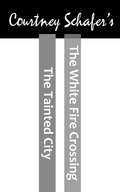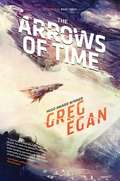- Table View
- List View
The Departure (The Owner)
by Neal AsherVisible in the night sky the Argus Station, its twin smelting plants like glowing eyes, looks down on nightmare Earth. From Argus the Committee keep an oppressive control: citizens are watched by cams systems and political officers, it's a world inhabited by shepherds, reader guns, razor birds and the brutal Inspectorate with its white tiled cells and pain inducers. Soon the Committee will have the power to edit human minds, but not yet, twelve billion human being need to die before Earth can be stabilized, but by turning large portions of Earth into concentration camps this is achievable, especially when the Argus satellite laser network comes fully online . . . This is the world Alan Saul wakes to in his crate on the conveyor to the Calais incinerator. How he got there he does not know, but he does remember the pain and the face of his interrogator. Informed by Janus, through the hardware implanted in his skull, about the world as it is now Saul is determined to destroy it, just as soon as he has found out who he was, and killed his interrogator . . .
Eclipse 1
by Jonathan StrahanAn eclipse is a rare and unusual event, when the world is transformed and the sky becomes a dark eldritch thing. It's a time when anything could happen, when any kind of story just might be true. That sense of the strange and wonderful guides Eclipse: New Science Fiction and Fantasy, the first volume in an exciting new annual anthology series edited by acclaimed anthologist Jonathan Strahan.Set to become a major event on the science fiction and fantasy calendar,Eclipse: New Science Fiction and Fantasy gathers together new science fiction and fantasy stories by the best writers working today. You can see that in Eclipse 1, which features extraordinary tales by Peter S. Beagle, Jack Dann & Paul Brandon, Terry Dowling, Andy Duncan, Jeffrey Ford, Kathleen Ann Goonan, Eileen Gunn, Gwyneth Jones, Ellen Klages, Maureen F. McHugh, Garth Nix, Lucius Shepard, Bruce Sterling and Ysabeau S. Wilce.
The Croning
by Laird BarronStrange things exist on the periphery of our existence, haunting us from the darkness looming beyond our firelight. Black magic, weird cults and worse things loom in the shadows. The Children of Old Leech have been with us from time immemorial. And they love us...Donald Miller, geologist and academic, has walked along the edge of a chasm for most of his nearly eighty years, leading a charmed life between endearing absent-mindedness and sanity-shattering realization. Now, all things must converge. Donald will discover the dark secrets along the edges, unearthing savage truths about his wife Michelle, their adult twins, and all he knows and trusts. For Donald is about to stumble on the secret......of The Croning.From Laird Barron, Shirley Jackson Award-winning author of The Imago Sequence and Occultation, comes The Croning, a debut novel of cosmic horror.
The Collected Fiction of William Hope Hodgson: The Night Land & Other Romances
by William Hope HodgsonThe fourth of a five volume set collecting all of Hodgson's published fiction. Each volume contains one of Hodgson's novels, along with a selection of thematically-linked short fiction.
The Loving Dead
by Amelia BeamerKate and Michael are roommates living in the Oakland hills, working at the same Trader Joes supermarket. A night of drunken revelry changes their lives forever, but not in the way that anyone would expect. A slow-spreading plague of zombie-ism breaks out at their house party, spreading amongst their circle of friends, and simultaneously through the Bay Area. This zombie plague — an STD of sorts — is spread through sex and kissing, turning its victims into mindless, horny, voracious killers. Thrust into extremes by this slow- motion tragedy, Kate and Michael are forced to confront the choices they&’ve made in their lives, and their fears of commitment, while trying to stay alive and reunite in the one place in the Bay Area that&’s likely to be safe and secure from the zombie hoards: Alcatraz.
Veil of the Deserters (Bloodsounder's Arc)
by Jeff SalyardsBraylar is still poisoned by the memories of those slain by his unholy flail Bloodsounder, and attempts to counter this sickness have proven ineffectual. The Syldoonian Emperor, Cynead, has solidified his power in unprecedented ways, and Braylar and company are recalled to the capital to swear fealty. Braylar must decide if he can trust his sister, Soffjian, with the secret that is killing him. She has powerful memory magics that might be able to save him from Bloodsounder&’s effects, but she has political allegiances that are not his own. Arki and others in the company try to get Soffjian and Braylar to trust one another, but politics in the capital prove to be complicated and dangerous. Deposed emperor Thumarr plots to remove the repressive Cynead, and Braylar and Soffjian are at the heart of his plans. The distance between &“favored shadow agent of the emperor&” and &“exiled traitor&” is unsurprisingly small. But it is filled with blind twists and unexpected turns. Before the journey is over, Arki will chronicle the true intentions of Emperor Cynead and Soffjian.
Field of Fantasies: Baseball Stories of the Strange and Supernatural
by Rick WilberOf all the sports played across the globe, none has more curses, superstitions, or supernatural events like baseball, America&’s national pastime. While some of these can easily be explained, there are just as many that cannot.Field of Fantasies delves right into that superstition with short stories written by several key authors about baseball and the supernatural. Whether it&’s a frozen curveball, a robot pitcher, or fantasy outcomes (the Cubs winning the World Series!), these terrific stories are ones that fans of science fiction will enjoy, while fans of baseball will find strangely believable.Included in this wonderful anthology are stories from such prolific authors as:Stephen KingJack KerouacKaren Joy FowlerRod SerlingW. P. KinsellaAnd many more!Never has a book combined the incredible events of baseball and science fiction like Field of Fantasies does. Whether you&’re a sport or science fiction fan, these stories will appeal not only to your fandom, but also to your appreciation and acceptance of the unknown taking place on the baseball diamond. If you&’ve ever held a bat or glove in your hand (or just watched the game on TV), you&’ll be enthralled by these terrific tales that range from the sandlot to the sold-out stadium.
All Darkness Met
by Glen CookBefore there was Black Company, there was the Dread Empire, an omnibus collection the first three Dread Empire novels: A Shadow of All Night's Falling, October's Baby and All Darkness Met. For the first time in eBook format, the A Cruel Wind collection is available as individual books.
A Cruel Wind
by Glen CookBefore there was Black Company, there was the Dread Empire, an omnibus collection the first three Dread Empire novels: A Shadow of All Night's Falling, October's Baby and All Darkness Met.
Warlock: Book Two of The Dark War Trilogy (Darkwar Trilogy #2)
by Glen CookThe world grows colder with each passing year, the longer winters and ever-deepening snows awaking ancient fears within the Dengan Packstead, fears of invasion by armed and desperate nomads, attack by the witchlike and mysterious Silth, able to kill with their minds alone, and of the Grauken, that desperate time when intellect gives way to buried cannibalistic instinct, when meth feeds upon meth. For Marika, a young pup of the Packstead, loyal to pack and family, times are dark indeed, for against these foes, the Packstead cannot prevail. But awakening within Marika is a power unmatched in all the world, a legendary power that may not just save her world, but allow her to grasp the stars themselves. From Glen Cook, author of the Black Company and Dread Empire novels. The second book in the Darkwar series.
Ghost Pirates and Others
by William Hope HodgsonWilliam Hope Hodgson was a contemporary of H. P. Lovecraft, and Clark Ashton Smith, and was one of the most important and influential fantasists of the 20th century. His novel The Ghost Pirates is a take-no-prisoners supernatural adventure story that is just as powerful today as it was 100 years ago.In addition to his landmark novel, this volume contains some of his most influential short fiction; from his supernatural detective Thomas Carnacki to tales of the mysterious Sargasso Sea. The Ghost Pirates and Others is the perfect introduction to the magic, mystery and adventure of William Hope Hodgson.
Afternoon Tea at the Sunflower Café
by Milly JohnsonThe heartwarming and feel-good read from the Sunday Times bestselling author&‘The feeling you get when you read a Milly Johnson book should be bottled and made available on the NHS&’ Debbie Johnson When Connie discovers that Jimmy Diamond, her husband of more than twenty years, is planning to leave her for his office junior, her world is turned upside down. Determined to salvage her pride, she resolves to get her own back. Along with Della, Jimmy's right-hand woman at his cleaning firm, Diamond Shine, and the cleaners who meet at the Sunflower Café, she'll make him wish he had never underestimated her. Then Connie meets the charming Brandon Locke, a master chocolatier, whose kindness starts to melt her soul. Can the ladies of the Sunflower Cafe help Connie scrub away the hurt? And can Brandon make her trust again?Praise for Milly Johnson: 'Every time you discover a new Milly book, it&’s like finding a pot of gold' heat 'A glorious, heartfelt novel' Rowan Coleman &‘Absolutely loved it. Milly's writing is like getting a big hug with just the right amount of bite underneath. I was rooting for Bonnie from the start' Jane Fallon &‘Bursting with warmth and joie de vivre&’ Jill Mansell &‘Warm, optimistic and romantic&’ Katie Fforde
In Darkness Waiting
by John ShirleyNo writer combines the "delight in dread" with social consciousness and metaphysical meaning the way John Shirley does. Although In Darkness Waiting begins in much the same vein as many horror novels (mysterious deaths; a small town invaded by evil; plucky, attractive young lovers; the logical level-headed doctor; some salt-of-the-earth townsfolk...) by its end you will have discovered it is not "just another horror novel." With its exploration of the "insect" inside us all, In Darkness Waiting proves more relevant today than ever. Considering a read of In Darkness Waiting is like considering a trip through the Amazon with no weapons and no vaccinations and no shoes. It's like contemplating a journey in the Arctic clad only in your underwear. Or maybe it's more like dropping into one of those spelunker's challenges, those chilling pitch-black shafts into the Earth's crust-and when you get down there your light burns out and you remember the chitinous fauna of the cavern...Unlike undertaking those endeavors, you can get through the harrowing pages of In Darkness Waiting alive (although we are not promising you'll remain unscathed.) Towards the end you'll discover one of the most extreme yet literate passages ever written. It may well be the most outré scene ever created.But John Shirley wasn't after shock alone. Shock is never enough for him.
Phantom Effect
by Michael AronovitzJonathan Martin Delaware Deseronto is a six-foot-five serial killer with a problem. He&’s stuck out on I-476 in a heavy November rainstorm with two flat tires and the dead bodies of a cop and a co-ed named Marissa Madison in his trunk. Desperate to get off the highway, he drives his car on its back rims towards Exit 6. The car stalls on the ramp and Deseronto uses the last of its momentum to plunge over the crest of a steep slope and crash into a length of concrete pipe below. The car comes to rest on the edge of a construction site where machines are positioned to tear down an old Motel 6.For Deseronto, the worst is yet to come. Marissa Madison had been a psychic of sorts while alive, using her ability to assist people in their personal journeys. Now, the ghost of Marissa will utilize her strange gift, trapping Deseronto in the abandoned motel, and forcing him to live the last, fatal week of her own life as a passive passenger in her body . . . Soon, Deseronto will experience something truly horrific: the mind-numbing terror of being stalked by himself.
Knife Sworn: Tower and Knife 1 (Tower and Knife)
by Mazarkis WilliamsMazarkis William&’s debut novel, The Emperor&’s Knife, was praised for its exotic settings, gripping intrigue, and vivid, full-blooded characters. Now Williams returns to the sumptuous palaces and treacherous back alleys of the Cerani Empire, where intrigue, passion, and dangerous magic threaten the very soul of a newly-crowned emperor.After spending most of his life in captivity and solitude, Sarmin now sits upon the Petal Throne of Cerana. But his reign is an uneasy one. Ambitious generals and restless soldiers want war at any cost. An insidious foreign religion stirs fear among the people and the court. And the emperor&’s own heart is torn between two very different women: Mesema, a Windreader princess of the northern plains, and Grada, a lowborn untouchable with whom Sarmin shares a unique bond. A natural-born mage, Sarmin also carries within him a throng of bodiless spirits whose conflicting memories and desires force him to wage a private battle for his sanity.In times past, a royal assassin known as the Emperor&’s Knife served as the keen edge of justice, defending the throne from any and all menaces, but the last Knife has perished and his successor has yet to be named. For his own safety, and that of the empire, Sarmin must choose his own loyal death-dealer . . . .but upon whom can be he bestow the bloody burden of the Knife-Sworn?
The Best Horror of the Year (Best Horror of the Year)
by Ellen DatlowDarkness, both literal and psychological, holds its own unique fascination. Despite our fears, or perhaps because of them, readers have always been drawn to tales of death, terror, madness, and the supernatural, and no more so than today when a wildly imaginative new generation of dark dreamers is carrying on in the tradition of Poe and Lovecraft and King, crafting exquisitely disturbing literary nightmares that gaze without flinching into the abyss—and linger in the mind long after.Multiple award-winning editor Ellen Datlow knows the darkest corners of fiction and poetry better than most. Once again, she has braved the haunted landscape of modern horror to seek out the most chilling new works by both legendary masters of the genre and fresh young talents. Here are twisted hungers and obsessions, human and otherwise, along with an unsettling variety of spine-tingling fears and fantasies. The cutting edge of horror has never cut deeper than in this comprehensive showcase of the very best the field has to offer. Enter at your own risk.
Zero Point (The Owner)
by Neal AsherEarth&’s Zero Asset citizens no longer face extermination from orbit. Thanks to Alan Saul, the Committee&’s network of control is a smoking ruin and its robotic enforcers lie dormant. But power abhors a vacuum and, scrambling from the wreckage, comes the ruthless Serene Galahad. She must act while the last vestiges of Committee infrastructure remain intact – and she has the means to ensure command is hers. On Mars, Var Delex fights for the survival of Antares Base, while the Argus Space Station hurls towards the red planet. And she knows whomever, or whatever, trashed Earth is still aboard. Var must save the base, while also dealing with the first signs of rebellion. And aboard Argus Station, Alan Saul&’s mind has expanded into the local computer network. In the process, he uncovers the ghastly experiments of the Humanoid Unit Development, the possibility of eternal life, and a madman who may hold the keys to interstellar flight. But Earth&’s agents are closer than Saul thinks, and the killing will soon begin.
Ghosts of Yesterday
by Jack CadyGhosts of Yesterday is a stunning collection by multiple-award-winning author Jack Cady The Off Season, The Haunting of Hood Canal. Cady captures the sights and emotions of America, from the Pacific Northwest ("Jeremiah"), to the streets of San Francisco ("The Lady With the Blind Dog"), to the Midwest-heartland ("Halloween 1942"), along the roads and highways in between ("The Ghost of Dive Bomber Hill"), and back into the history of the American Southeast ("The Time That Time Forgot"). The stories that make up Ghosts of Yesterday are detailed and realistic portraits of the world that, despite (and perhaps because) of their authenticity, manage to convey a sense of wonder and fantastic, where anything is possible. The characters and places that Cady brings to life demonstrate clearly why he is one of the most versatile and respected writers today... His stories will move you, and change the way you look at the world.
Witches Be Crazy
by Logan HunderReal heroes never die. But they do get grouchy in middle age.The beloved King Ik is dead, and there was barely time to check his pulse before the royal throne was supporting the suspiciously shapely backside of an impostor pretending to be Ik&’s beautiful long-lost daughter. With the land&’s heroic hunks busy drooling all over themselves, there&’s only one man left who can save the kingdom of Jenair. His name is Dungar Loloth, a rural blacksmith turned innkeeper, a surly hermit and an all-around nobody oozing toward middle age, compensating for a lack of height, looks, charm, and tact with guts and an attitude.Normally politics are the least of his concerns, but after everyone in the neighboring kingdom of Farrawee comes down with a severe case of being dead, Dungar learns that the masquerading princess not only is behind the carnage but also has similar plans for his own hometown. Together with the only person senseless enough to tag along, an eccentric and arguably insane hobo named Jimminy, he journeys out into the world he&’s so pointedly tried to avoid as the only hope of defeating the most powerful person in it. That is, if he can survive the pirates, cultists, radical Amazonians, and assorted other dangers lying in wait along the way.Logan J. Hunder&’s hilarious debut blows up the fantasy genre with its wry juxtaposition of the fantastic and the mundane, proving that the best and brightest heroes aren&’t always the best for the job.
Brave New Worlds
by John Joseph AdamsFrom Huxley's Brave New World, to Orwell's 1984, to Atwood's The Handmaid's Tale, dystopian books have always been an integral part of both science fiction and literature, and have influenced the broader culture discussion in unique and permanent ways. Brave New Worlds brings together the best dystopian fiction of the last 30 years, demonstrating the diversity that flourishes in this compelling subgenre.This landmark tome contains stories by Ursula K. Le Guin, Cory Doctorow, M. Rickert, Paolo Bacigalupi, Orson Scott Card, Neil Gaiman, Ray Bradbury, and many others.
The Emperors Knife: Tower and Knife 2 (Tower and Knife)
by Mazarkis WilliamsThere is a cancer at the heart of the mighty Cerani Empire: a plague that marks each victim with a fragment of a greater design. Geometric patterns spread across the skin, until the victim dies in agony or becomes a Carrier, doing the bidding of an evil intelligence.The lost prince Sarmin, the emperor's only surviving brother, lies locked in a hidden room. As the pattern draws closer to the palace he is at last remembered: now he awaits a bride, Mesema, a Windreader from the northern plains. She is accustomed to riding free across the grasslands and finds the Imperial Court stifling, but she soon realizes the politicking is not a game. It is in deadly earnest.Eyul, the imperial assassin, is burdened by the atrocities he has committed. As commanded, he bears the emperor's Knife to the desert in search of a cure for the pattern-markings.As long-planned conspiracies boil over into open violence, the enemy moves towards victory. Now only three people stand in his way: a lost prince, a world-weary killer, and a young girl from the steppes who saw a path in a pattern once, among the waving grasses.
The Windup Girl
by Paolo BacigalupiWinner of the Hugo and Nebula awards for best novel, a new edition of the break-out science fiction debut featuring additional stories and a Q&A with the author.Anderson Lake is AgriGen&’s Calorie Man, sent to work undercover as a factory manager in Thailand while combing Bangkok&’s street markets in search of foodstuffs thought to be extinct, hoping to reap the bounty of history&’s lost calories.Emiko is the Windup Girl, a strange and beautiful creature. Emiko is not human; she is an engineered being, grown and programmed to satisfy the decadent whims of a Kyoto businessman, but now abandoned to the streets of Bangkok. Regarded as soulless beings by some, devils by others, New People are slaves, soldiers, and toys of the rich in this chilling near future in which calorie companies rule the world, the oil age has passed, and the side effects of bio-engineered plagues run rampant across the globe.What happens when calories become currency? What happens when bio-terrorism becomes a tool for corporate profits and forces mankind to the cusp of post-human evolution? Bacigalupi delivers one of the most highly-acclaimed science fiction novels of the twenty-first century.In this brand new edition celebrating the book&’s reception into the canon of celebrated modern science fiction, accompanying the text are two novelettes exploring the dystopian world of The Windup Girl, the Theodore Sturgeon Award-winning &“The Calorie Man&” and &“Yellow Card Man.&” Also included are course-work questions for use in the classroom, and an exclusive Q&A with the author describing his writing process, the political climate into which his debut novel was published, and the future of science fiction.
The Shattered Sigil Series
by Courtney SchaferThe first two entries in The Shattered Sigil series! Containing The Whitefire Crossings and The Tainted City for the first time together in one edition.
Arrows of Time (Orthogonal)
by Greg EganIn an alien universe where space and time play by different rules, interstellar voyages last longer for the travellers than for those they left behind. After six generations in flight, the inhabitants of the mountain-sized spacecraft the Peerless have used their borrowed time to develop advanced technology that could save their home world from annihilation.But not every traveller feels allegiance to a world they have never seen, and as tensions mount over the risks of turning the ship around and starting the long voyage home, a new complication arises: the prospect of constructing a messaging system that will give the Peerless news of its own future.While some of the crew welcome the opportunity to be warned of impending dangers - and perhaps even hear reports of the ship's triumphant return - others are convinced that knowing what lies ahead will be oppressive, and that the system will be abused. Agata longs for a chance to hear a message from the ancestors back on the home world, proving that the sacrifices of the travellers have not been in vain, but her most outspoken rival, Ramiro, fears that the system will undermine every decision the travellers make.When a vote fails to settle the matter and dissent erupts into violence, Ramiro, Agata and their allies must seek a new way to bring peace to the Peerless - by traveling to a world where time runs in reverse.The Arrows of Time is the final volume of the Orthogonal trilogy, bringing a powerful and surprising conclusion to the epic story of the Peerless that began with The Clockwork Rocket and The Eternal Flame.
Rules of '48
by Jack CadyMaster storyteller Jack Cady's final novel, Rules of '48, is a stirring semi-autobiographical examination of changing social conventions, and the development of the American conscience in the aftermath of the greatest war in history. In a city with roots deep in the Confederacy, five men endure seven deadly weeks that forever alter their perceptions of the world.
